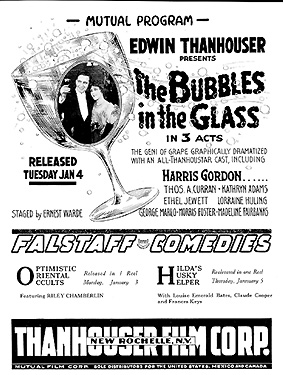 Volume II: Filmography
Volume II: Filmography Volume II: Filmography
Volume II: Filmography

Advertisement from Reel Life (F-930)
January 4, 1916 (Tuesday)
Length: 3 reels
Character: Drama; Than-O-Play
Director: Ernest C. Warde
Scenario: Lloyd F. Lonergan
Cameramen: William Zollinger, Frank Gary
Cast: Lorraine Huling (Barbara Adams, the girl), Harris Gordon (Kenneth Rintool, her fiancé), Morris Foster (glass blower), Madeline Fairbanks (glass blower's sweetheart), Ethel Jewett (vineyard worker), Thomas A. Curran (Benton), Kathryn Adams (Benton's wicked wife), George Marlo (a dissolute clerk)
Location: Some scenes were filmed in Buffalo, New York.
Note: A full-page Thanhouser advertisement in the October 30a, 1915 issue of The Moving Picture World noted that The Bubbles in the Glass would be released on November 6, 1915. Apparently, the advertisement was placed in error, for schedules of the period indicated that Mr. Meeson's Will was to be shown, and was shown, on November 6, 1915.
SYNOPSIS, Reel Life, January 4, 1916:
"Not a preachment, but an eloquent warning against extravagance and a cowardly attitude toward life, is the deeply affecting three-act Than-O-Play Feature, The Bubbles in the Glass, released by the Mutual Film Corporation January 4th. Harris Gordon is excellent in the role of the disconsolate young man who has failed in the financial world, and who has yet to learn the saving power of love.
"The play opens in a fashionable restaurant where Kenneth Rintool is giving a select dinner to Barbara Adams, his fiancée, and a few friends. Rintool refuses to accompany the party to the opera. He takes farewell to Barbara, saying that he has business to attend to, and later that night intends 'going on a journey.' All through Lohengrin the girl is haunted by the sense that something is wrong with her fiancé. Meanwhile, Rintool sits alone in the deserted cafe over an almost empty bottle of champagne. He will sip that, and then end it all! Ruined by his own extravagance - there is little for him to live for. The costly wine before him typifies his chief fault. These few drops remaining shall be his last. He pours the champagne into a glass, and the bubbles wink at him. Then, in the iridescent globules appear tragedies of the vineyard and of the wine presses - after that, his own career passes slowly in review. 'I am insignificant enough!' muses the would-be suicide. 'I mean no more to any living soul than one of these bubbles!'
"He draws from his pocket the fatal powder, and nerves himself to take 'the journey.' A soft arm finds its way about Rintool's neck, pleading eyes and a sweet, imploring voice recalls him to himself. Barbara has slipped away from the opera - and now she finds her fears justified. His money is gone? But health and love remain. When they are married she can help him fight his way back to fortune. Realization of his folly, and of the suffering he would have caused to this loyal, loving woman, sweep over Rintool. Seizing Barbara in his arms, he learns for the first time how love has the power to make a man live."
REVIEW, The Moving Picture World, January 1, 1916:
"This three-part production contains an excellent temperance lesson. The story for the play was written by Lloyd Lonergan. The film is intended to teach the lesson of total abstinence, and shows many of the disadvantages which arise from addiction to alcohol. This picture will be welcomed by temperance workers."
# # #
Copyright © 1995 Q. David Bowers. All Rights Reserved.